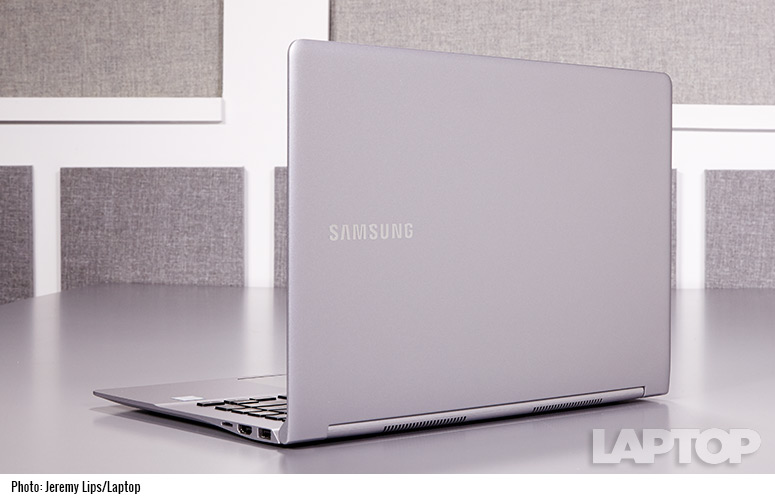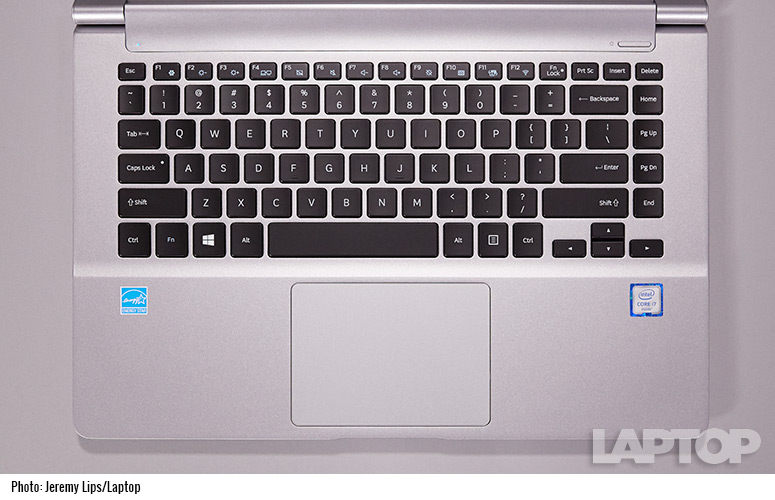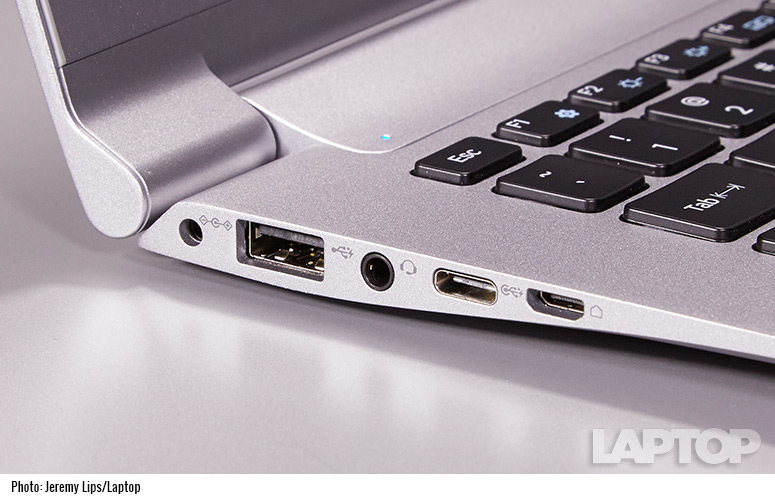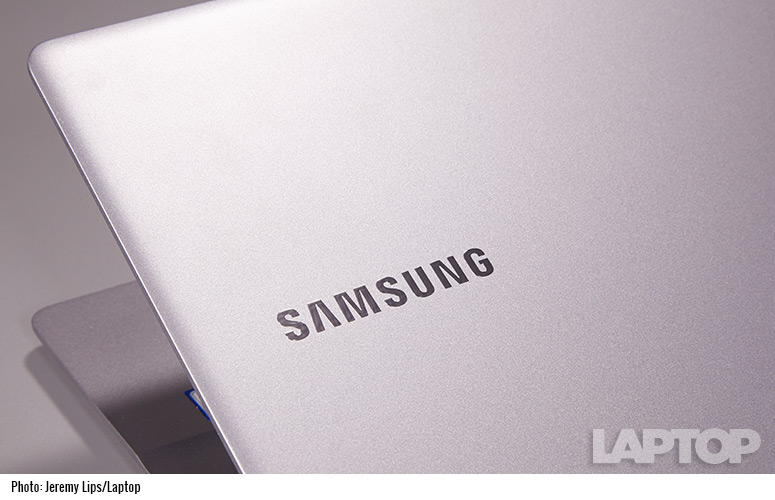Laptop Mag Verdict
The Samsung Notebook 9 15-inch combines a big display with extreme portability and strong Core i7 performance.
Pros
- +
Extremely light
- +
Great touchpad
- +
Strong performance
- +
Bright display with wide viewing angles
Cons
- -
Shallow keyboard
- -
Screen colors can be too warm
Why you can trust Laptop Mag
If you need a 15-inch laptop that will go anywhere in a backpack or briefcase without adding heft, you'll want to consider the Samsung Notebook 9 15-inch. Samsung has slipped powerful components -- such as a Core i7 CPU, a vibrant 1080p display and a 256GB solid-state drive -- into a $1,200 laptop that weighs just 2.77 pounds. However, we wish the supersvelte Notebook 9 offered a comfier keyboard.
Design
Samsung's 15-inch Notebook 9 is so unassuming that you almost forget it's a big-screen notebook -- it's slim and silver with little branding, with the exception of Samsung's logo on the lid. The computer's deck and lid's magnesium-and-aluminum build seemed solid in my hands and felt like a premium product.
Opening the lid reveals a black, Chiclet-style keyboard, as well as a deck that places your wrists a few millimeters over the keyboard for better ergonomics. The bottom bezel on the 15-inch display is quite large, but the edges on the side and top of the screen are slim enough not to be noticeable.
At 13.6 x 9.3 x 0.57 inches, the Notebook 9 has a svelte footprint; it's not as wide as some other premium 15-inch laptops. For comparison, the 15-inch LG Gram, the HP Spectre x360 15t and the Dell XPS 15 are just over 14 inches wide, but the Asus ZenBook Pro UX501VW is even wider, at 15.1 inches. The Notebook 9 is light and portable, at just 2.77 pounds, while the Dell XPS 15 (4.4 pounds), the Spectre x360 15t (4.1 pounds) and the Asus (5 pounds) are all significantly heavier. However, the LG Gram 15 is a featherweight by comparison, at 2.1 pounds.
"The glass-covered touchpad is one of the most comfortable touchpads I've used on a Windows machine."
Keyboard and Touchpad
The Notebook 9 keyboard's ergonomic design was comfortable for my wrists, but not my fingers. The keys have just 1.35 millimeters of travel and require 55 grams of force to depress, which caused my fingers to bottom out when I typed at full speed. Additionally, there's a little flex in the keyboard, especially if you type with a lot of force, as I do.
Sign up to receive The Snapshot, a free special dispatch from Laptop Mag, in your inbox.
On the 10fastfingers.com typing test, I still managed to type at a rate of 104 words per minute with an error rate of 2 percent. That's about average for me, but I'd be much happier typing on a keyboard with deeper travel.
The glass-covered 4.2 x 3.0-inch touchpad is one of the most comfortable I've used on a Windows machine, and it feels like one you would find on a MacBook. It was very responsive to gestures as I swiped windows to and from the desktop, scrolled up and down web pages, and pinched to zoom in maps.
MORE: Best Samsung Laptops
Display
The 15-inch, 1920 x 1080 display on the Notebook 9 produces crisp images with extremely vibrant, but slightly inaccurate, colors. I watched the most recent trailer for X-Men: Apocalypse and was impressed by how much detail I could see in Angel's wings and debris flying through the air. But I found that the colors had a golden bias: Skin tones across the board were too warm, appearing orange and yellow, while Mystique's blue hue was bright enough to appear cartoonish. Psylocke's sword, usually an intense purple, looked too pink.
At 348 nits, the Notebook 9's display is brighter than the panels on the LG Gram (246 nits), the Spectre x360 15t (246 nits), the Asus ZenBook Pro UX501VW (289 nits) and the mainstream category average (249 nits).
The Notebook 9 covers an impressive 110.4 percent of the sRGB color gamut, but the ZenBook Pro (111 percent) and the HP Spectre x360 (119 percent) offer a few more shades. The LG Gram covers 101 percent of the gamut.
Despite its yellow tinge, the screen delivered a solid Delta-E color accuracy score of 1.2 (the closer to 0, the better). Other 15-inch mainstream laptops fared much worse: The Gram scored 3.5, the HP Spectre x360 15t notched 4.1 and the ZenBook Pro UX501VW registered 4.37.
Viewing angles on the Notebook 9 were strong, as colors remained true even at 80 degrees to the left and right.
With a Core i7-6500U processor, 8GB of RAM and a 256GB SSD, the Notebook 9 is a productivity and multimedia powerhouse.
Audio
The speakers on the bottom of the Notebook 9 produce sound that is just adequate. When I listened to the Avett Brothers' "Head Full of Doubt/Road Full of Promise," I could hear clear vocals and backing instruments through this laptop. However, I found that the bass was a little weak, and I wanted to turn the volume just a smidge louder.
The laptop produced far better sound on my desk and a conference room table than it did on my lap; on occasion, my leg covered the speaker, leading to muffled music and dialogue.
Ports and Webcam
The Notebook 9's svelte chassis doesn't have a lot of room for ports, but you'll find all of the standard ones. The left side of the laptop houses the power jack, a USB 3.0 port, headphone and microphone input, a USB Type-C (for charging and data) port and a wired LAN port that you can use with an optional adapter for an Ethernet connection. On the right are a microSD card slot (we'd prefer a full-size SD card slot), an HDMI port and another USB 3.0 port.
The 720p webcam takes fairly sharp photos that are marred only by some visual noise. A detailed selfie I took in our well-lit break room showed the stitching on my sweater and individual hairs on my face. The picture's colors were quite accurate, showing off my skin tone and cream-colored sweater as they appear in real life.
Performance
With a Core i7-6500U processor, 8GB of RAM and a 256GB SSD, the Notebook 9 is a productivity and multimedia powerhouse. My normal workload didn't max out the i7 processor. With 12 Chrome tabs open, one of which was streaming a 1080p video, and OpenOffice Writer running in the background, I found the slightest hint of lag when switching sites. However, it wasn't enough of a slowdown to keep me from opening up a few more tabs.
The Notebook 9 beat its chief competitor, the LG Gram 15 Z960 (2.3-GHz Intel Core i5 6200U, 8GB of RAM) on the Geekbench 3 CPU performance test, with a score 7,002 versus the Gram's 5,831. The HP Spectre x360 15t (2.3 GHz Intel Core i5-6200U) scored a lower mark of 6,376, but the ZenBook Pro (2.6-GHZ Core i7-6700HQ) and the Dell XPS 15 (Core i7-6700HQ CPU) had scores of 11,472 and 13,023, respectively.
When it came to copying 4.97GB of mixed media files -- including videos, photos and music -- the Notebook 9's 256GB SSD took 32 seconds, for a rate of 157.13 MBps. That's just 2 seconds ahead of both the Spectre x360 15t and the Gram 15. The XPS 15 and the ZenBook Pro were faster, at 339.3 MBps and 462.7 MBps, respectively.
The Notebook 9 can crunch numbers in a hurry; it paired 20,000 names and addresses in the OpenOffice Spreadsheet Macro Test in 4 minutes and 4 seconds -- faster than both the Gram (4:32) and the Spectre x360 (4:31), as well as the category average of 5:16. Both the XPS 15 (2:00) and the ZenBook Pro UX501VW (3:41) were significantly speedier than the rest of the bunch.
While the Notebook 9 will work just fine for low-end games like World of Warcraft, it's not equipped for resource-intensive titles like Dark Souls III and Far Cry Primal. With its integrated Intel HD Graphics 520 GPU, Samsung's laptop notched a score of 68,149, which is just below the category average of 70,777 but better than the integrated graphics on the LG Gram 15 (53,664) and the HP Spectre x360 (64,632). The XPS 15 and the ZenBook Pro UX501VW's scores of 118,086 and 116,309, respectively, indicated the ability to play intensive games at lower settings, thanks to their Nvidia GeForce 960M graphics cards.
MORE: Laptops with the Longest Battery Life
Battery Life
The Notebook 9 is extremely portable, and unlike on its closest competitor, you'll be able to get through most of the day without hunting for an outlet. Samsung's laptop lasted for 7 hours and 20 minutes on the Laptop Mag Battery Test, which involves continuous web browsing over Wi-Fi at 100 nits of brightness. That's longer than the mainstream category average of 5:45 and the LG Gram 15 (6:02). However, the beefier ZenBook Pro UX501VW (8:00), Spectre x360 (8:27), and Dell XPS 15 (10:26) all endured longer.
Samsung claims that the USB Type-C port offers quick charging, which the company defines as "about 90 minutes." We charged the laptop with our Innergie USB-C charger (the laptop doesn't come with one of its own), and after an hour and a half, we had an 83 percent charge. Within another half an hour, we had a full charge, which is slightly slower than advertised.
Heat
Because of the Notebook 9's slim profile, any heat generated by the machine's components has few places to escape. But somehow, the system manages to keep its cool, making for a consistently comfortable experience. In our tests, the machine never rose above our 95-degree comfort threshold. After we streamed full-screen HD video from Hulu for 15 minutes, the touchpad reached 81 degrees Fahrenheit, the center of the keyboard hit 90 degrees and the bottom of the laptop was a cool 86 degrees.
Software and Warranty
The Samsung Notebook 9 comes with a fair amount of utility and diagnostic software, as well as a few pieces of bloatware. Samsung-branded apps include S Agent, S Service (which provides customer support) and Samsung Update (which keeps track of current software updates for your device).
SideSync 4.1 allows you to make calls and texts from your Android phone or share data among devices, while Samsung Settings lets you adjust your preferences and make security adjustments, as well as provides a convenient user manual.
The only preloaded third-party apps are Candy Crush Soda Saga, Flipboard and Twitter. The Notebook 9 comes with a one-year warranty on parts and labor.
Configurations
The 15-inch Samsung Notebook 9 that we reviewed includes a Core i7-6500U CPU, 8GB of RAM, a 256GB SSD and a 1920 x 1080p display, for $1,199.
For $1,499.99, you can upgrade to the Notebook 9 Pro, which has a 15.6-inch 3840 x 2160 touch screen, 8GB of RAM, a 256GB SSD and an Nvidia GeForce GTX 950M graphics card.
A 13-inch version of the Notebook 9 has the same storage, RAM and display resolution as our review model, but it features a 6th-generation Core i5 processor and costs $999.99.
Bottom Line
If you want a highly portable laptop with a large display for serious work, web browsing, video watching and more, the Samsung Notebook 9 15-inch is a very good choice. This notebook offers heavy-duty Core i7 power in a superlight design. And while it's not as ridiculously light as the LG Gram 15, this Samsung laptop lasts more than an hour longer on a charge. We just wish the keyboard offered more travel, which would have made for a more comfortable typing experience. And while the display is colorful and bright, it's a bit on the warm side.
Other 15-inch laptops deliver more power, including the Dell XPS 15 and the Asus ZenBook Pro UX501VW. But if you'd prefer a big-screen system that you can slip into your bag and take anywhere, the Notebook 9 would make a good choice.
"The glass-covered touchpad is one of the most comfortable touchpads I've used on a Windows machine."
Samsung Notebook 9 (15-inch, 2016) Specs
| Bluetooth | Bluetooth 4.1 |
| Brand | Samsung |
| CPU | Intel Core i7-7500U |
| Card Slots | microSD |
| Company Website | http://www.samsung.com/ |
| Display Size | 15 |
| Graphics Card | Nvidia 940MX |
| Hard Drive Size | 256GB SSD |
| Hard Drive Type | SSD |
| Native Resolution | 1920x1080 |
| Operating System | Windows 10 Home |
| Ports (excluding USB) | USB Type-C, HDMI, Headphone/Mic, USB 3.0 |
| RAM | 16GB |
| Size | 13.7 x 9.03 x 0.61 |
| Touchpad Size | 4.2 x 3.0 inches |
| USB Ports | 3 |
| Warranty/Support | 1 Year Standard Parts and Labor |
| Weight | 2.73 pounds |
| Wi-Fi | 802.11ac |
Andrew is a contributing writer at Laptop Mag. His main focus lies in helpful how-to guides and laptop reviews, including Asus, Microsoft Surface, Samsung Chromebook, and Dell. He has also dabbled in peripherals, including webcams and docking stations. His work has also appeared in Tom's Hardware, Tom's Guide, PCMag, Kotaku, and Complex. He fondly remembers his first computer: a Gateway that still lives in a spare room in his parents' home, albeit without an internet connection. When he’s not writing about tech, you can find him playing video games, checking social media and waiting for the next Marvel movie.







